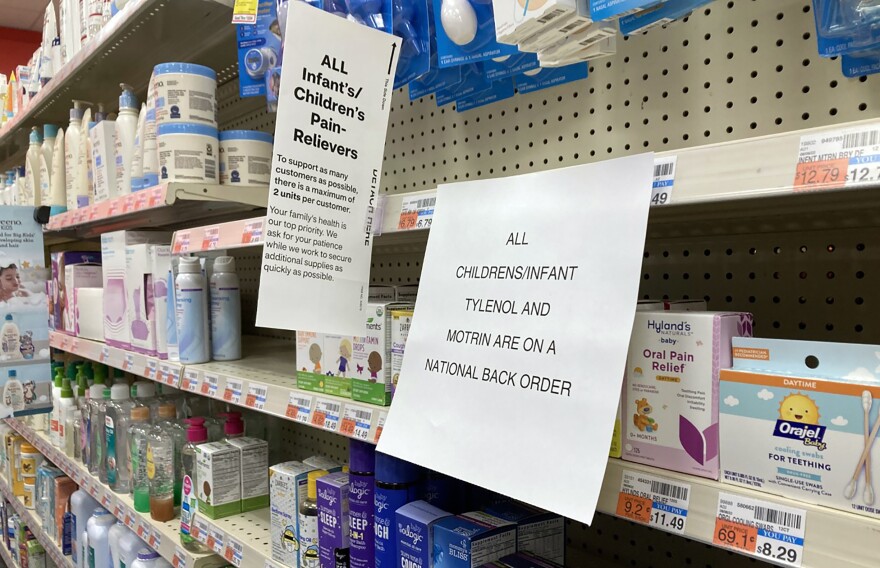Both Dr. Mayank Amin and his wife are pharmacists. They’re also parents to a one-and-a-half-year-old child, with another on the way.
- Widespread sickness among children during a “tripledemic” of respiratory illnesses this year is driving up demand for children’s pain relievers and fever reducers
- This has left drugstore chains and smaller community pharmacies across the nation in short supply.
- Even pharmacists have not escaped the shortage’s effects.
They try to be well prepared for any illnesses or medical needs that may arise in their household, especially during winter with the rise of circulating seasonal viruses.
That includes having pain relievers or cough and cold medicines on hand, which would seem fairly easy, given their professions. Amin owns and works at Skippack Pharmacy in Montgomery County.
“Sometimes when my wife tells me, ‘Make sure we have this in our medicine cabinet,’ I always wondered why, when I can just bring it home from the pharmacy on any given day?” Amin said.
But widespread sickness among children during a “tripledemic” of respiratory illnesses this year is driving up demand for children’s pain relievers and fever reducers, leaving drugstore chains and smaller community pharmacies across the nation in short supply.
Amin said Skippack has not escaped the shortage’s effects.
“We had the parent of a one-and-a-half-year-old today call us and they were looking for just Motrin, Tylenol, any kind of fever reducer,” he said. “I looked at our shelves, it was completely empty.”
Demand for these medications is outpacing the current supply, andsome pharmacies have capped the number of products that can be bought in a single purchase.
Amin said the good news is that medications are still coming in. While one pharmacy may be out of supply on any given day, another store may have something in stock.
However, high utilization of these medications at more homes means there’s an increased potential for accidentally giving the wrong dosing, experts say.
Dr. Jeanette Trella said the region’s Poison Control Center at Children’s Hospital of Philadelphia has seen double the monthly increase in calls related to cough and cold medications compared to the same month-to-month uptick measured last year.
“We could also postulate that if a medication that we’re used to using, say Tylenol liquid, is not available and we have to try other medication types or dosage forms, that would increase our risk of medication errors,” she said.
Trella is a pharmacist and senior director of the Center for Public Readiness and Response at CHOP, which houses the regional Poison Control Center for eastern Pennsylvania and Delaware.
To avoid unintentional therapeutic errors, as they’re classified by poison control, Trella said reading the labels on the back of medications is critical. Most will have dosage ranges for children based on their ages and weights.
“It’s also important to understand the difference between a [milliliter] and a teaspoon, and make sure that we are using measuring devices so that we can give that more precise dosing for our smaller kids,” she said.
Amin said brand-name medications like Tylenol and Motrin might be popular, but the generic versions of those medicines are just as effective.
“If you happen to go to a store and you see ibuprofen for children or ibuprofen for infants or acetaminophen, it’s the exact same thing,” he said. “Make sure you grab that bottle, because that will also help you out.”
However, high utilization of these medications at more homes means there’s an increased potential for accidentally giving the wrong dosing, experts say.
Dr. Jeanette Trella said the region’s Poison Control Center at Children’s Hospital of Philadelphia has seen double the monthly increase in calls related to cough and cold medications compared to the same month-to-month uptick measured last year.
“We could also postulate that if a medication that we’re used to using, say Tylenol liquid, is not available and we have to try other medication types or dosage forms, that would increase our risk of medication errors,” she said.
Trella is a pharmacist and senior director of the Center for Public Readiness and Response at CHOP, which houses the regional Poison Control Center for eastern Pennsylvania and Delaware.
To avoid unintentional therapeutic errors, as they’re classified by poison control, Trella said reading the labels on the back of medications is critical. Most will have dosage ranges for children based on their ages and weights.
“It’s also important to understand the difference between a [milliliter] and a teaspoon, and make sure that we are using measuring devices so that we can give that more precise dosing for our smaller kids,” she said.
Amin said brand-name medications like Tylenol and Motrin might be popular, but the generic versions of those medicines are just as effective.
“If you happen to go to a store and you see ibuprofen for children or ibuprofen for infants or acetaminophen, it’s the exact same thing,” he said. “Make sure you grab that bottle, because that will also help you out.”

